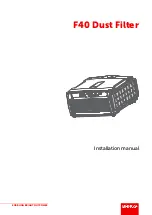
Rainstore
3
Storm Drainage Detention & Exfiltration with Geotextile Fabric
6
be installed and must be discarded. Call ISI for replacement pieces at 800-
233-1510
. Rainstore
3
units
CANNOT BE CUT
to fit the hole. Each unit must be
installed whole. No Partial unit is allowed unless making room for a maintenance
port (see 5.6).
C.
A powered lift can be used as a small crane to lower Rainstore
3
cells into place.
The powered lift should use wide strapping around the Rainstore
3
cells. The
strapping should be placed under the pallet the Rainstore
3
cells are on to avoid
damage to the bottom of the cells. To avoid product damage or replacement, make
sure the strapping isn’t too tight around the top, bottom, or sides of the stacked
cells.
D.
There are two sets of banding surrounding the
Rainstore
3
cells and pallet. Only cut the metal
banding that attaches the cells to the pallet, BUT
NOT the banding that holds the cell stacks
together. Remove and discard the pallet from
under the Rainstore3 units. If white paper divides
the stacked cells, remove and discard that as well.
E.
Final positioning of cells should be done by hand
by at least two workers. The cells are placed side
by side,
with the grid side down
on the
geotextile fabric layer. Align bumpers on each
side of all stacked cells to ensure square
placement.
5.6 Maintenance Ports:
A.
Depending on the size of the maintenance port, one or four Rainstore
3
columns
can be removed to install a maintenance port. The Rainstore
3
units can ONLY be
cut for maintenance port installation – no other cutting is permitted. The
Rainstore
3
cells can be cut using a powered cutter, such as a chain saw or a
reciprocating saw.
NOTE: Cut ONLY the GRID between the cylinders, NOT
the cylinders themselves.
The location of the maintenance port should be clearly
marked with tape or paint before Rainstore
3
cells are cut.
5.7 Geogrid – Second Layer:
A.
The second geogrid layer is applied directly over the installed Rainstore
3
cells and
provides a walking surface for workers. This layer temporarily interlocks the cell
stacks and prevents the geotextile fabric from being penetrated.
B.
The geogrid easily unrolls with two workers. The seams should overlap at least 12
inches.


























